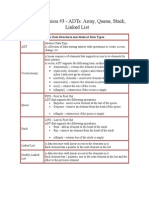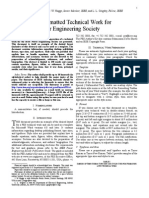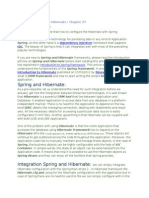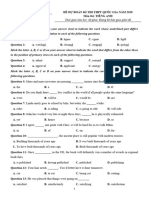0 ratings0% found this document useful (0 votes)
56 viewsDatabase Programming Standards
The document provides database programming standards and guidelines for naming conventions, structures, formatting, coding practices and performance tips. Key points include:
- Tables, columns, indexes and other database objects should be named following specific conventions with prefixes identifying the type and module.
- Data should be normalized to third normal form and data types like TEXT avoided when possible.
- Code should be properly formatted and indented for readability with comments used.
- Coding best practices like parameterizing queries, avoiding cursors and temporary tables, and basic validation in the frontend should be followed.
- Performance can be optimized by using appropriate joins over subqueries, analyzing execution plans, leveraging derived tables and limiting transactions.
Uploaded by
Sabari NathanCopyright
© © All Rights Reserved
Available Formats
Download as DOC, PDF, TXT or read online on Scribd
0 ratings0% found this document useful (0 votes)
56 viewsDatabase Programming Standards
The document provides database programming standards and guidelines for naming conventions, structures, formatting, coding practices and performance tips. Key points include:
- Tables, columns, indexes and other database objects should be named following specific conventions with prefixes identifying the type and module.
- Data should be normalized to third normal form and data types like TEXT avoided when possible.
- Code should be properly formatted and indented for readability with comments used.
- Coding best practices like parameterizing queries, avoiding cursors and temporary tables, and basic validation in the frontend should be followed.
- Performance can be optimized by using appropriate joins over subqueries, analyzing execution plans, leveraging derived tables and limiting transactions.
Uploaded by
Sabari NathanCopyright
© © All Rights Reserved
Available Formats
Download as DOC, PDF, TXT or read online on Scribd
You are on page 1/ 10
DATABASE PROGRAMMING STANDARDS
DATABASE PROGRAMMING STANDARDS
Naming Conventions:
Tables:
Each table will have a 3-letter Module nae under!core 3 letter t"#e $M!t %or Ma!ter& Trn %or Tran!action& T#
%or Te#orar" and Stc %or Static'& which will be uni(ue to identi%" the Module and table t"#e)
For example:
*or +lient Ma!ter the table nae will be Gen,M!t,+lient
The %ir!t 3 character! -Gen. i! to identi%" Module nae and M!t u!ed to identi%" table t"#e)
I% the #ro/ect0#roduct ha! !in1le odule then directl" !tart with table t"#e)
For example:
*or +lient Ma!ter the table nae will be M!t,+lient
Columns (fiels!:
*ield nae !hould re%lect the content to be !tored)
For example2
3) +lient+ode
4) 5nit+ode
+lient+ode i! the %ield nae to re%er client6! code toward! all the odule! and table!)
Ine"es:
The %ollowin1 rule !hould be %ollowed %or nain1 an inde7
Rule2 ID8,9TableNae:,9colun! !e#arated b" ,:
For examples:
Id7,Product!,ProductID
P#ima#$ %e$s:
The %ollowin1 rule ha! to be %ollowed %or nain1 a #riar" ;e"
Rule2 P<,9TableNae:
For examples:
P;,Gen,M!t,+lient
&o#eign %e$s: The %ollowin1 rule ha! to be %ollowed %or nain1 %orei1n ;e"
Rule2 *<,9TableNae3:,9TableNae4:
For example:
*;,+lient,Account!
'a#iables:
=ariable! !hould be #re%i7ed with >v,6
For example:
v,Sli#
Constants:
*or con!tant! whole word !hould be in ca#! e7ce#t #re%i7 c,)
For example:
c,S?IP
Cu#so#s:
+ur!or! !hould be #re%i7ed with @ cur, @
For example:
+ur,+ontract
Pa#amete#s:
Paraeter! !hould be #re%i7ed with @ #, @
For example:
#,+lient
P#o(eu#es:
Procedure! !hould be #re%i7ed with @9Module Nae:,Pr, @
For example:
Gen,Pr,Branch,*etch
Ahere Gen indicate! Module nae and Pr re%er! to #rocedure)
&un(tions:
*unction! !hould be #re%i7ed with @ 9Module Nae:,*n,@
For example:
Der,*n,+alculate,Bro;era1e
T#igge#s:
Tri11er! !hould be #re%i7ed with @ 9Module Nae:,T1,@
For example:
Der,T1,In!ert,Trade
Pa()age:
Pac;a1e !hould be #re%i7ed with @9Module Nae:,P;, @
For example:
Der,P;1,Buer",?oo;u#
'ie*s:
=iew! !hould be #re%i7ed with @ 9Module Nae:,=w,@
For example:
Der,=w,+ontract,Detail!
Mate#iali+e 'ie*s:
MaterialiCed =iew! !hould be #re%i7ed with @ 9Module Nae:,Mv,@
For example:
Der,Mv,+ontract,Detail!
Se,uen(es:
Se(uence! !hould be #re%i7ed with >9Module Nae:,Se(,6
For example:
Der,Se(,Ban;,+ode
S$non$ms:
S"non"! !hould be #re%i7ed with @ 9Module Nae:,S"n, @
For example:
Der,S"n,Aor;!;ill
Summa#$:
OB-ECT E.AMP/E
Table! M!t,+lient
+olun! +lient+ode
Inde7e! Id7,Product!,ProductID
Priar" <e"! P;,Gen,M!t,+lient
*orei1n <e"! *;,+lient,Account!
=ariable! v,Sli#
+on!tant! c,S?IP
+ur!or! +ur,+ontract
Paraeter! #,+lient
Procedure! Gen,Pr,Branch,*etch
*unction! Der,*n,+alculate,Bro;era1e
Tri11er! Der,T1,In!ert,Trade
Pac;a1e! Der,P;1,Buer",?oo;u#
=iew! Der,=w,+ontract,Detail!
MaterialiCed =iew! Der,Mv,+ontract,Detail!
Se(uence! Der,Se(,Ban;,+ode
S"non"! Der,S"n,Aor;!;ill
Gene#al Stana#s to be follo*e u#ing atabase 0#og#amming:
Do not u!e !#ace! in the nae o% databa!e ob/ect!
Do not u!e SB? ;e"word! a! the nae o% databa!e ob/ect!
In ca!e! where thi! i! nece!!ar"& !urround the ob/ect nae with brac;et!& !uch a! DEearF
Pre%i7 table nae! with the owner nae $e)1) dbo)9Table Nae:'
St#u(tu#e
Normalize data to third normal form (Only depending on the project requirement).
Do not use TEXT as a data type use the ma!imum allo"ed characters of #$%&'$% instead
"hene(er it is possi)le.
*n #$%&'$% data columns+ do not default to N,-- use an empty string instead as much as
possi)le+ create stored procedures on the same data)ase as the main ta)les they "ill )e
accessing.
&o#matting
,se upper case for all ./- 0ey"ords
o .E-E&T+ *N.E%T+ ,1D$TE+ 2'E%E+ $ND+ O%+ -*3E+ etc.
*ndent code to impro(e reada)ility
&omment code )loc0s that are not easily understanda)le
o ,se single4line comment mar0ers(44)
o %eser(e multi4line comments (56.. ..65) for )loc0ing out sections of code
,se single quote characters to delimit strings.
o Nest single quotes to e!press a single quote or apostrophe "ithin a string
,se parentheses to increase reada)ility
o 2'E%E (color78red8 $ND (size 7 9 O% size 7 :))
,se ;E<*N..END )loc0s only "hen multiple statements are present "ithin a conditional code
segment.
,se one )lan0 line to separate code sections.
,se spaces so that e!pressions read li0e sentences.
=ormat >O*N operations using indents
1lace .ET statements )efore any e!ecuting code in the procedure.
Coing:
Optimize queries using the tools pro(ided )y ./- .er(er "hene(er necessary
Do not use .E-E&T 6
%eturn multiple result sets from one stored procedure to a(oid trips from the
application ser(er to ./- ser(er
$(oid unnecessary use of temporary ta)les
o ,se ?Deri(ed ta)les? or &TE (&ommon Ta)le E!pressions) "here(er possi)le+ as they
perform )etter
$(oid using @A as a comparison operator
,se .ET NO&O,NT ON at the )eginning of stored procedures
$(oid using cursors or application loops to do inserts
o *nstead+ use *N.E%T *NTO
=ully qualify ta)les and column names in >O*Ns
=ully qualify all stored procedure and ta)le references in stored procedures. ,se appropriate
aliases needed
Do not define default (alues for parameters.
o *f a default is needed+ the front end "ill supply the (alue.
Do not use the %E&OB1*-E option for stored procedures.
1lace all DE&-$%E statements )efore any other code in the procedure.
Do not use column num)ers in the O%DE% ;C clause.
Do not use <OTO.
&hec0 the glo)al (aria)le DDE%%O% immediately after e!ecuting a data manipulation statement
(li0e *N.E%T5,1D$TE5DE-ETE)+ so that you can roll)ac0 the transaction if an error occurs
o Or use T%C5&$T&'
Do )asic (alidations in the front4end itself during data entry
Off4load tas0s+ li0e string manipulations+ concatenations+ ro" num)ering+ case con(ersions+ type
con(ersions etc.+ to the front4end applications if these operations are going to consume more &1,
cycles on the data)ase ser(er
$l"ays use a column list in your *N.E%T statements.
o This helps a(oid pro)lems "hen the ta)le structure changes (li0e adding or
dropping a column).
Binimize the use of N,--s+ as they often confuse front4end applications+ unless the applications
are coded intelligently to eliminate N,--s or con(ert the N,--s into some other form.
o $ny e!pression that deals "ith N,-- results in a N,-- output.
o The *.N,-- and &O$-E.&E functions are helpful in dealing "ith N,--
(alues.
Do not use the identitycol or ro"guidcol unless it is una(oida)le.
$(oid the use of cross joins+ if possi)le.
2hen e!ecuting an ,1D$TE or DE-ETE statement+ use the primary 0ey in the
2'E%E condition+ if possi)le. This reduces error possi)ilities.
$(oid dynamic ./- statements as much as possi)le.
$ccess ta)les in the same order in your stored procedures and triggers consistently
Do not call functions repeatedly "ithin your stored procedures+ triggers+ functions and )atches.
$(oid "ild4card characters at the )eginning of a "ord "hile searching using the -*3E 0ey"ord+
as these results in an inde! scan+ "hich defeats the purpose of an inde!. ,se the &'$% data type
for a column only "hen the column is non4nulla)le.
Do not use "hite space in identifiers.
The %ET,%N statement is meant for returning the e!ecution status only+ )ut not data.
Pe#fo#man(e Ti0s:
Ba0e use of joins rather than su) queries+ union or intersection in DB- statements.
,se the graphical e!ecution plan in /uery $nalyzer or .'O21-$NETEXT or .'O21-$NE$--
commands to analyze your queries. Ba0e sure your queries do an F*nde! see0F instead of an
F*nde! scanF or a FTa)le scanF. Ta)le scan or an inde! scan is highly undesira)le and should )e
a(oided "here possi)le.
&onsider the follo"ing query to find the second highest offer price from the *tems ta)leG
.E-E&T B$X (1rice)
=%OB 1roducts
2'E%E *D *N
(
.E-E&T TO1 : *D
=%OB 1roducts
O%DE% ;C 1rice Desc
)
The same query can )e re4"ritten using a deri(ed ta)le+ as sho"n )elo"+ and it performs
generally t"ice as fast as the a)o(e queryG
.E-E&T B$X (1rice)
=%OB (
.E-E&T TO1 : 1rice
=%OB 1roducts
O%DE% ;C 1rice DE.& )
This suppresses messages li0e ?(9 ro"(s) affected)? after e!ecuting *N.E%T+ ,1D$TE+ DE-ETE
and .E-E&T statements. 1erformance is impro(ed due to the reduction of net"or0 traffic.
Cou cannot directly "rite or update te!t data using the *N.E%T or ,1D$TE statements. *nstead+
you ha(e to use special statements li0e %E$DTEXT+ 2%*TETEXT and ,1D$TETEXT. .o+ if you don?t
ha(e to store more than H3; of te!t+ use the &'$% (HIII) or #$%&'$% (HIII) data type
instead.
Dynamic ./- tends to )e slo"er than static ./-+ as ./- .er(er must generate an e!ecution
plan at runtime. *= and &$.E statements come in handy to a(oid dynamic ./-. This helps to a(oid
deadloc0s.
3eep transactions as short as possi)le.
Touch the minimum amount of data possi)le during a transaction.
Ne(er "ait for user input in the middle of a transaction.
Do not use higher le(el loc0ing hints or restricti(e isolation le(els unless they are a)solutely
needed.
Cou might need the length of a string (aria)le in many places of your procedure+ )ut don?t call
the -EN function "hene(er it?s needed. *nstead+ call the -EN function once and store the result in a
(aria)le for later use.
*= EX*.T. (.E-E&T 9 =%OB 1roducts 2'E%E *D 7 JI)
*nstead OfG
*= EX*.T. (.E-E&T &O,NT(*D) =%OB 1roducts 2'E%E *D 7 JI)
&'$%(9II)+ "hen N,--+ "ill consume 9II )ytes+ resulting in space "astage. 1refera)ly+ use
#$%&'$%(9II) in this situation. #aria)le4length columns ha(e (ery little processing o(erhead
compared "ith fi!ed4length columns.
$l"ays head the procedures+ pac0ages+ functions and Triggers "ith the )elo" details
/*
*
* Created By :
* Created Date :
* Purpose :
* Modification History
* ------------------------------------------------------------------
* Name Date Description
* ------------------------------------------------------------------
*
*
*/
%emo(e unused codes and o)jects regularly.
Bo(e static e!pressions outside of loops and ./- statements.
&atch all e!ceptions and con(ert to meaningful return codes )efore returning to non4./- host
programs.
Do not o(erload an e!ception "ith multiple errors.
$(oid hard4codes.
%eturn message should )e standardized for all forms.
,se incremental &OBB*Ts to a(oid roll)ac0 segment errors "hen changing large num)ers of
ro"s.
Ne(er use a cursor =O% loop to fetch just one ro".
,se ;,-3 &O--E&T to impro(e performance of multi4ro" queries
Encapsulate dynamic ./- parsing to impro(e error detection and cleanup.
You might also like
- Microsoft Activex Data Objects.: Sqlconnection Sqlcommand Sqldatareader SQL System - Data.SqlclientNo ratings yetMicrosoft Activex Data Objects.: Sqlconnection Sqlcommand Sqldatareader SQL System - Data.Sqlclient5 pages
- Practical Session #3 - Adts: Array, Queue, Stack, Linked ListNo ratings yetPractical Session #3 - Adts: Array, Queue, Stack, Linked List11 pages
- Design Report Title: 0688555: Computer Arithmetic, Fall 2013No ratings yetDesign Report Title: 0688555: Computer Arithmetic, Fall 20132 pages
- Setting Up Xpediter - Help With Screen ShotNo ratings yetSetting Up Xpediter - Help With Screen Shot11 pages
- Preparation of Papers For EECCIS J (Petunjuk Penulisan J Eeccis)No ratings yetPreparation of Papers For EECCIS J (Petunjuk Penulisan J Eeccis)3 pages
- ML81N Creating An Entry Sheet 03-29-2007No ratings yetML81N Creating An Entry Sheet 03-29-200728 pages
- Preparation of A Formatted Technical Work For The IEEE Power Engineering SocietyNo ratings yetPreparation of A Formatted Technical Work For The IEEE Power Engineering Society4 pages
- Joiner Transformation: Example: To Join EMP and DEPT TablesNo ratings yetJoiner Transformation: Example: To Join EMP and DEPT Tables4 pages
- Digital Simulation of Numerical Relay Using MatlabNo ratings yetDigital Simulation of Numerical Relay Using Matlab6 pages
- SQL, PL/SQL Faq About Triggers:: Insert Update DeleteNo ratings yetSQL, PL/SQL Faq About Triggers:: Insert Update Delete25 pages
- A Poker-Dealing Machine Is Supposed To Deal Cards at Random, As If From An InfiniteNo ratings yetA Poker-Dealing Machine Is Supposed To Deal Cards at Random, As If From An Infinite4 pages
- Insert, Select, Update & Delete CommandsNo ratings yetInsert, Select, Update & Delete Commands5 pages
- Semester - Iii CS 3102 Java Programming Lab Assignments Department of Computer Science and Engineering, B. I. T. Mesra Cs & ItNo ratings yetSemester - Iii CS 3102 Java Programming Lab Assignments Department of Computer Science and Engineering, B. I. T. Mesra Cs & It5 pages
- Digital Spread Spectrum Systems: Wright State University James P. Stephens Lecture NotesNo ratings yetDigital Spread Spectrum Systems: Wright State University James P. Stephens Lecture Notes10 pages
- SAS Interview Questions: Arundathi InfotechNo ratings yetSAS Interview Questions: Arundathi Infotech61 pages
- Project Mainly Based On KLT Tools: at HomeNo ratings yetProject Mainly Based On KLT Tools: at Home29 pages
- Complete Reference To Informatica: Joiner TransformationNo ratings yetComplete Reference To Informatica: Joiner Transformation7 pages
- Ctec1801 Pseudo Past Paper For 2011 12 PDFNo ratings yetCtec1801 Pseudo Past Paper For 2011 12 PDF7 pages
- Measurement and Instrumentation Experiment No. #2 High Resistance Measurement by Loss of Charge MethodNo ratings yetMeasurement and Instrumentation Experiment No. #2 High Resistance Measurement by Loss of Charge Method2 pages
- SQL Tutorial For Interview: The SQL Select Distinct StatementNo ratings yetSQL Tutorial For Interview: The SQL Select Distinct Statement11 pages
- Cpe 272 Digital Logic Laboratory: Lab #3 Introduction To The Gal/Three Bit Adder Fall 2007No ratings yetCpe 272 Digital Logic Laboratory: Lab #3 Introduction To The Gal/Three Bit Adder Fall 200710 pages
- Python for Beginners: This comprehensive introduction to the world of coding introduces you to the Python programming languageFrom EverandPython for Beginners: This comprehensive introduction to the world of coding introduces you to the Python programming languageNo ratings yet
- Yonatan Zunger'S Blog: Non-Suck ResumésNo ratings yetYonatan Zunger'S Blog: Non-Suck Resumés24 pages
- Collections: Q1. What Are Limitations of Object Arrays?No ratings yetCollections: Q1. What Are Limitations of Object Arrays?16 pages
- Q1. What Are Limitations of Object Arrays?No ratings yetQ1. What Are Limitations of Object Arrays?17 pages
- What Is A Test Case?: Software Development Life Cycle Software TestingNo ratings yetWhat Is A Test Case?: Software Development Life Cycle Software Testing26 pages
- What Is Inner Class and When We Should Go For Inner Classes?No ratings yetWhat Is Inner Class and When We Should Go For Inner Classes?7 pages
- System Requirements Analysis. Feasibility Study Systems Analysis and Design Code Generation Testing Maintenance ImplementationNo ratings yetSystem Requirements Analysis. Feasibility Study Systems Analysis and Design Code Generation Testing Maintenance Implementation3 pages
- Improving Student's Writing A Descriptive Paragraph by Using National Geographic FilmNo ratings yetImproving Student's Writing A Descriptive Paragraph by Using National Geographic Film2 pages
- The Implications of Knowledge Acquisition PDF100% (1)The Implications of Knowledge Acquisition PDF77 pages
- Accusative Clitic Doubling in Dominican Spanish, 2014No ratings yetAccusative Clitic Doubling in Dominican Spanish, 2014120 pages
- Polish Words Minimum To Learn DictionaryNo ratings yetPolish Words Minimum To Learn Dictionary69 pages
- Vocab Sanjeevani Series by Prashant Sir Day 18 Antonyms 03 PrintableNo ratings yetVocab Sanjeevani Series by Prashant Sir Day 18 Antonyms 03 Printable3 pages
- Present Simple или Present Continuous ex-sNo ratings yetPresent Simple или Present Continuous ex-s4 pages
- GROUP ASSIGNNMNT - Speaking Metaphorically ExerciseNo ratings yetGROUP ASSIGNNMNT - Speaking Metaphorically Exercise4 pages
- English 9 Module 4 - First and Second Conditionals100% (1)English 9 Module 4 - First and Second Conditionals10 pages
- - Đề chuẩn Tiếng Anh 2020 - Đề 1 (Mini test)No ratings yet- Đề chuẩn Tiếng Anh 2020 - Đề 1 (Mini test)18 pages
- '50 Question Level Test - Intermediate' Quiz - Exercise & WorksheetNo ratings yet'50 Question Level Test - Intermediate' Quiz - Exercise & Worksheet9 pages
- Bert:: Mr. Rivera: Mr. Rivera: Mr. RiveraNo ratings yetBert:: Mr. Rivera: Mr. Rivera: Mr. Rivera17 pages
- 14-Verb + Object + Infinitive Gerund - Verb PatternsNo ratings yet14-Verb + Object + Infinitive Gerund - Verb Patterns3 pages
- Bigger Is Not Always Better: Belajar Membandingkan Ses Uatu ComparisonNo ratings yetBigger Is Not Always Better: Belajar Membandingkan Ses Uatu Comparison6 pages
- Köçərli Sevda-Online MİQ VƏ Sertifikasiya Hazırlığı 0557312011No ratings yetKöçərli Sevda-Online MİQ VƏ Sertifikasiya Hazırlığı 05573120116 pages
- Microsoft Activex Data Objects.: Sqlconnection Sqlcommand Sqldatareader SQL System - Data.SqlclientMicrosoft Activex Data Objects.: Sqlconnection Sqlcommand Sqldatareader SQL System - Data.Sqlclient
- Practical Session #3 - Adts: Array, Queue, Stack, Linked ListPractical Session #3 - Adts: Array, Queue, Stack, Linked List
- Design Report Title: 0688555: Computer Arithmetic, Fall 2013Design Report Title: 0688555: Computer Arithmetic, Fall 2013
- Preparation of Papers For EECCIS J (Petunjuk Penulisan J Eeccis)Preparation of Papers For EECCIS J (Petunjuk Penulisan J Eeccis)
- Preparation of A Formatted Technical Work For The IEEE Power Engineering SocietyPreparation of A Formatted Technical Work For The IEEE Power Engineering Society
- Joiner Transformation: Example: To Join EMP and DEPT TablesJoiner Transformation: Example: To Join EMP and DEPT Tables
- Digital Simulation of Numerical Relay Using MatlabDigital Simulation of Numerical Relay Using Matlab
- SQL, PL/SQL Faq About Triggers:: Insert Update DeleteSQL, PL/SQL Faq About Triggers:: Insert Update Delete
- A Poker-Dealing Machine Is Supposed To Deal Cards at Random, As If From An InfiniteA Poker-Dealing Machine Is Supposed To Deal Cards at Random, As If From An Infinite
- Semester - Iii CS 3102 Java Programming Lab Assignments Department of Computer Science and Engineering, B. I. T. Mesra Cs & ItSemester - Iii CS 3102 Java Programming Lab Assignments Department of Computer Science and Engineering, B. I. T. Mesra Cs & It
- Digital Spread Spectrum Systems: Wright State University James P. Stephens Lecture NotesDigital Spread Spectrum Systems: Wright State University James P. Stephens Lecture Notes
- Complete Reference To Informatica: Joiner TransformationComplete Reference To Informatica: Joiner Transformation
- Measurement and Instrumentation Experiment No. #2 High Resistance Measurement by Loss of Charge MethodMeasurement and Instrumentation Experiment No. #2 High Resistance Measurement by Loss of Charge Method
- SQL Tutorial For Interview: The SQL Select Distinct StatementSQL Tutorial For Interview: The SQL Select Distinct Statement
- Cpe 272 Digital Logic Laboratory: Lab #3 Introduction To The Gal/Three Bit Adder Fall 2007Cpe 272 Digital Logic Laboratory: Lab #3 Introduction To The Gal/Three Bit Adder Fall 2007
- Python for Beginners: This comprehensive introduction to the world of coding introduces you to the Python programming languageFrom EverandPython for Beginners: This comprehensive introduction to the world of coding introduces you to the Python programming language
- Collections: Q1. What Are Limitations of Object Arrays?Collections: Q1. What Are Limitations of Object Arrays?
- What Is A Test Case?: Software Development Life Cycle Software TestingWhat Is A Test Case?: Software Development Life Cycle Software Testing
- What Is Inner Class and When We Should Go For Inner Classes?What Is Inner Class and When We Should Go For Inner Classes?
- System Requirements Analysis. Feasibility Study Systems Analysis and Design Code Generation Testing Maintenance ImplementationSystem Requirements Analysis. Feasibility Study Systems Analysis and Design Code Generation Testing Maintenance Implementation
- Improving Student's Writing A Descriptive Paragraph by Using National Geographic FilmImproving Student's Writing A Descriptive Paragraph by Using National Geographic Film
- Accusative Clitic Doubling in Dominican Spanish, 2014Accusative Clitic Doubling in Dominican Spanish, 2014
- Vocab Sanjeevani Series by Prashant Sir Day 18 Antonyms 03 PrintableVocab Sanjeevani Series by Prashant Sir Day 18 Antonyms 03 Printable
- GROUP ASSIGNNMNT - Speaking Metaphorically ExerciseGROUP ASSIGNNMNT - Speaking Metaphorically Exercise
- English 9 Module 4 - First and Second ConditionalsEnglish 9 Module 4 - First and Second Conditionals
- '50 Question Level Test - Intermediate' Quiz - Exercise & Worksheet'50 Question Level Test - Intermediate' Quiz - Exercise & Worksheet
- 14-Verb + Object + Infinitive Gerund - Verb Patterns14-Verb + Object + Infinitive Gerund - Verb Patterns
- Bigger Is Not Always Better: Belajar Membandingkan Ses Uatu ComparisonBigger Is Not Always Better: Belajar Membandingkan Ses Uatu Comparison
- Köçərli Sevda-Online MİQ VƏ Sertifikasiya Hazırlığı 0557312011Köçərli Sevda-Online MİQ VƏ Sertifikasiya Hazırlığı 0557312011









































































































